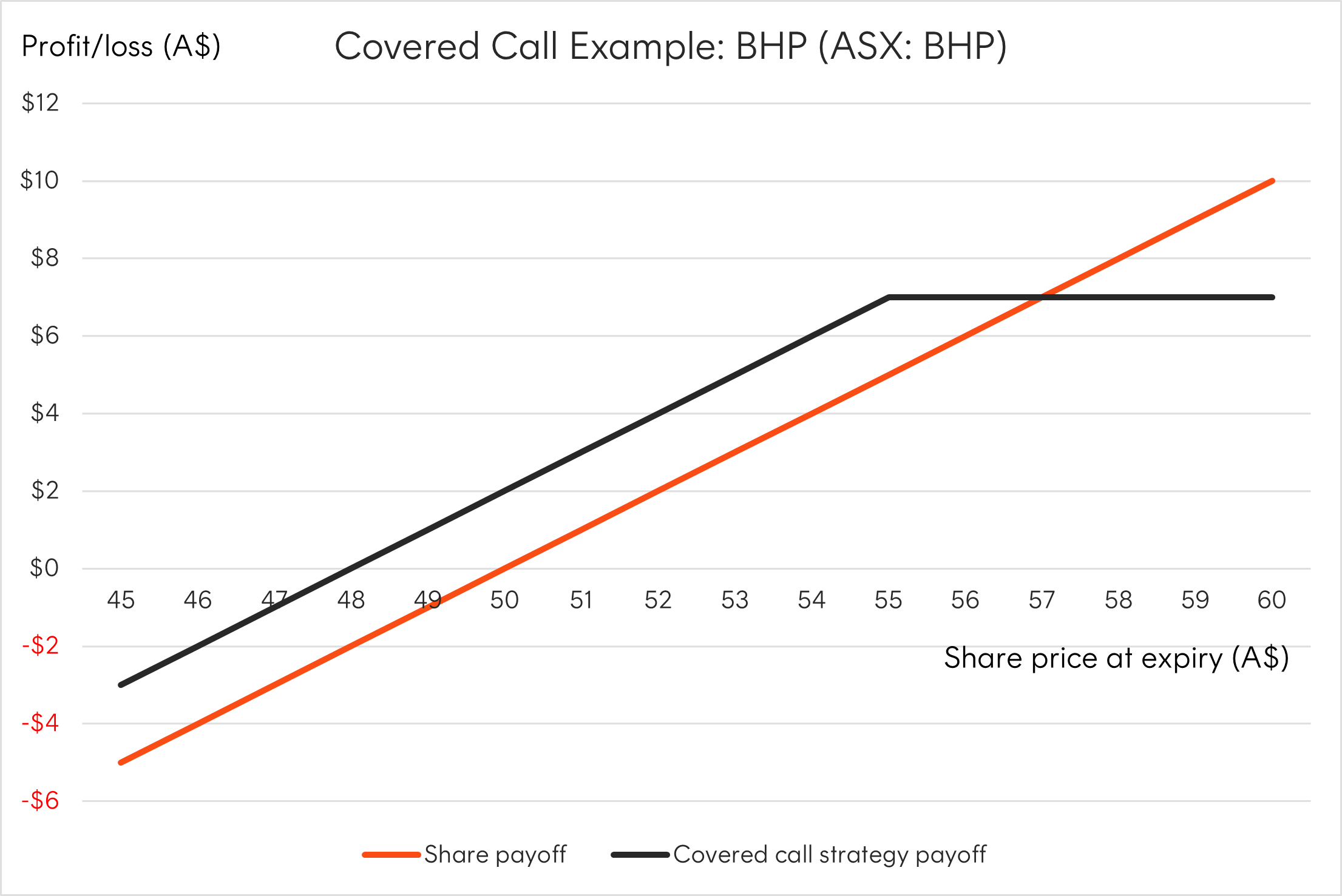Why this income strategy can thrive in uncertain markets
Investors can struggle with embracing the idea that volatility is a normal part of investing.
In a recent survey, Natixis Investment Managers asked over 7,000 retail investors from around the world whether they would accept more risk for better returns. Only 53% said yes – meaning nearly half were unwilling to do so.
That said, there’s a strategy that can help change that perspective. Covered call strategies allow investors to generate additional income by selling options over their shares. The extra income received can cushion some of the loss when share prices are flat or declining. Covered call strategies also cap the upside potential of an investor’s share portfolio, as discussed below.
How it works in practice
A covered call involves two elements: shares an investor already owns, and options they sell. The investor sells a call option, giving someone else the right to buy their shares at a predetermined higher price on or before a specified date in the future. In exchange for granting this right, the investor receives immediate payment which is called a ‘premium’.
Take BHP as an example. An investor owns 100 shares at $50 each. They sell a call option giving someone the right to buy those shares at $55.
The investor receives $2 per share for this agreement, generating a total of $200 in income.
From here, three outcomes are possible:
- If BHP trades below $55, the call option is not exercised – or in simpler terms the party who bought the call option will not exercise their right to buy the shares because they have not reached the specified higher price. The investor keeps both the shares and the $200 income.
- If BHP trades at exactly $55 and the buyer of the option exercises their right under the option, the investor will be required to sell at $55. They will earn the $5 per share increase from $50 to $55 ($500) and the $200 premium, for a total of $700.
- If BHP trades above $55, the investor earns the same amount as in Scenario 2 ($700) but loses out on any additional share price upside they could have made from selling the shares above $55. For example, if BHP trades at $60 the investor will not receive the benefit of the price increase from $55 to $60 as they will be obliged to sell the stock to the call option buyer for the agreed $55.
Covered call strategies work best when share prices are flat (also known as ‘sideway trading markets’ which means prices fluctuate between a narrow range for a period of time). Notice that even if BHP stays at $50, the investor earns $200. Their breakeven point is actually $48 (thanks to the premium), meaning they can withstand a 4% decline before making a loss. This income generation during flat, gradually rising or declining markets is the strategy’s key advantage.
On the other hand, selling a call option over your shares limits your upside. If the share price rises strongly, once it reaches the specified price of the option you have sold ($55 in this example), you won’t benefit any further – no matter how high the share price rises. This means if share prices rise strongly the covered call strategy can be expected to underperform.

For illustrative purposes only.
When does this approach work best?
As the above example shows, covered calls typically perform strongest when share prices are flat, declining or modestly rising. Conversely, covered calls can be expected to underperform during strong bull markets.
The following chart demonstrates how an Australian equity covered call strategy (ASX: YMAX) has performed over the last few years compared to the S&P/ASX 200.
The orange line depicts the cumulative relative returns of YMAX versus the S&P/ASX 200 price index (ASX 200), when this line is trending up YMAX is outperforming the ASX 200, when this line is trending down YMAX is underperforming the ASX 200.
The black line depicts the returns of the ASX 200 in isolation, to visualise how the market is performing.
During the past five years, as can be seen from the black line, the ASX 200 has experienced periods of strong gains, losses, and sideways trending periods – making this a useful period to demonstrate YMAX’s relative return profile in practice.
In the last few years, investors have experienced all of these scenarios – making it a useful chart to demonstrate theory in practice.
The red highlighted sections of the chart show periods of strong gains for the ASX 200 corresponding with YMAX underperforming (the orange line trending down). The green highlighted section shows a period of market decline corresponding with strong outperformance from YMAX and the blue section illustrates a sideways choppy market corresponding with YMAX’s cumulative relative returns grinding higher against the ASX 200.

Source: Bloomberg, Betashares, for the 5-year period ending on 30 September 2025. Chart shows cumulative returns for the Betashares Australian Top 20 Equities Yield Maximiser Complex ETF (YMAX) (using net total returns) versus the S&P/ASX 200 . You cannot invest directly in an index. Past performance is not indicative of future performance of any index or ETF. Chart is for illustrative purposes only.
These Betashares Funds employ a covered call strategy, meaning investors can participate in the benefits (and risks) of the strategy without having to become involved in the options market themselves.
As the Yield Maximiser Funds have been designed for investors who prioritise high income over capital growth, income returns can exceed total returns (i.e. income returns plus capital returns) in some circumstances. Also, as the Funds limit the potential upside growth of your portfolio, they may not be suitable for growth investors, or investors who hold a strongly bullish outlook.
Australian Top 20 Equities Yield Maximiser Complex ETF (ASX: YMAX) employs a covered call strategy over the 20 largest stocks on the ASX. The Fund aims to provide:
- Regular income that exceeds the dividend yield of an equivalent portfolio of 20 blue-chip (large, financially sound and well-established) Australian equities
- The potential for some capital growth, and
- Lower volatility of returns than an equivalent portfolio of 20 blue-chip Australian equities.
Over the past five years, as at 30 September 2025, the Fund has returned 10.82% p.a. after fees1. It has a current 12-month distribution yield of 7.6% and a franking level of 45.1%2. Together, YMAX offers a compelling combination of yield and franking that can help Australian investors boost their after-tax income.
S&P 500 Yield Maximiser Complex ETF (ASX: UMAX) employs the same strategy over the S&P 500 using index options. Index options are options contracts that are based on the entire S&P 500 index rather than individual company shares. The Fund aims to provide:
- Broad market exposure to the S&P 500 Index (US equities market)
- An attractive income yield that exceeds the dividend yield of an equivalent portfolio of underlying shares alone
- Lower overall volatility than the underlying share portfolio alone.
Over the past five years, as at 30 September 2025, the fund has returned 14.34% p.a. after fees1. It has a current 12-month distribution yield of 5.4% and pays distributions quarterly2.
Nasdaq 100 Yield Maximiser Complex ETF (ASX: QMAX) employs the same strategy as UMAX but applies it to the Nasdaq 100 instead. The Fund aims to provide:
- Regular income that exceeds the dividend yield of an equivalent portfolio of Nasdaq 100 stocks
- Exposure to global growth leaders, with the potential for some capital appreciation
- Lower volatility of returns than an equivalent portfolio of Nasdaq 100 stocks.
Since its inception in October 2022, as at 30 September 2025, the Fund has returned 22.65% p.a. It has a 7% 12-month distribution yield and pays distributions quarterly. Noting that this performance period is less than the 5 years shown for YMAX and UMAX (being a period of approximately 3 years), the strong returns of QMAX are reflective of the performance of the underlying index (Nasdaq 100) which has returned 30.44% p.a. over the same time period.
Turning volatility into an opportunity
Volatility remains constant in markets. For investors who prioritise income over capital growth, covered call strategies offer one approach to generate additional income from equity portfolios while creating a smoother investment experience by reducing overall volatility of returns.
Investors can learn more about Betashares’ range of income funds here.
3 stocks mentioned
3 funds mentioned

